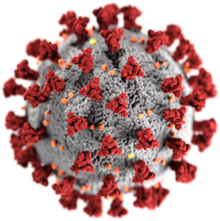Ogʻir oʻtkir nafas olish sindromi koronavirusi 2
(SARS-CoV-2dan yoʻnaltirildi)
Ogʻir oʻtkir nafas olish sindromi koronavirusi 2 (inglizcha Severe acute respiratory syndrome coronavirus 2, SARS-CoV-2)[2][3] bir zanjirli (+)RNK virusidir[4][5]. Ushbu virus odamlarda yuqumli boʻlib, COVID-19 koronavirus infeksiyasining sababchisi hisoblanadi[6][7].
| Ogʻir oʻtkir nafas olish sindromi koronavirusi 2 | |
|---|---|
 Koʻrinadigan koronali SARS-CoV-2 virionlarining elektron mikrografi | |
 SARS-CoV-2 virioni chizmasi | |
| Subgenus | Sarbecovirus |
| Shtamm | Ogʻir oʻtkir nafas olish sindromi koronavirusi 2 |
| Sinonimlar | 2019-nCoV, HCoV-19[1] |
| Virus | SARS-CoV-2 |
Epidemiologiya
tahrirAsosiy maqola: COVID-19 pandemiyasi
Maʼlum boʻlgan SARS-CoV-2 shtammi 2019-yil oxirida aholi oʻrtasida paydo boʻlganidan bir necha hafta oʻtgach sogʻliqni saqlash organlari tomonidan aniqlangan deb taxmin qilinmoqda[8]. Infeksiyaning dastlabki maʼlum boʻlgan holati 17-noyabr 2019-yilda aniqlangan deb taxmin qilinadi[9].
Manbalar
tahrir- ↑ Jiang S, Shi Z, Shu Y, et al. (19-fevral 2020-yil). „A distinct new name is needed for the new coronavirus“. The Lancet. 395-jild, № 10228. 949-bet. doi:10.1016/S0140-6736(20)30419-0. PMID 32087125. 17-mart 2020-yilda asl nusxadan arxivlandi. Qaraldi: 16-mart 2020-yil.
{{cite magazine}}: CS1 maint: date format () - ↑ „Coronavirus disease named Covid-19“. BBC News Online (11-fevral 2020-yil). 15-fevral 2020-yilda asl nusxadan arxivlangan. Qaraldi: 15-fevral 2020-yil.
- ↑ „New-type coronavirus causes pneumonia in Wuhan: expert“. Xinhua. 9-yanvar 2020-yilda asl nusxadan arxivlangan. Qaraldi: 9-yanvar 2020-yil.
- ↑ „CoV2020“. GISAID EpifluDB. 12-yanvar 2020-yilda asl nusxadan arxivlangan. Qaraldi: 12-yanvar 2020-yil.
- ↑ „W.H.O. Declares Global Emergency as Wuhan Coronavirus Spreads“. The New York Times (30-yanvar 2020-yil). 30-yanvar 2020-yilda asl nusxadan arxivlangan. Qaraldi: 30-yanvar 2020-yil.
- ↑ Chan JF, Yuan S, Kok KH, To KK, Chu H, Yang J, et al. (February 2020). „A familial cluster of pneumonia associated with the 2019 novel coronavirus indicating person-to-person transmission: a study of a family cluster“. The Lancet. 395-jild, № 10223. 514–523-bet. doi:10.1016/S0140-6736(20)30154-9. PMID 31986261.
- ↑ „What We Know Today about Coronavirus SARS-CoV-2 and Where Do We Go from Here“. Genetic Engineering and Biotechnology News (19-fevral 2020-yil). 14-mart 2020-yilda asl nusxadan arxivlangan. Qaraldi: 13-mart 2020-yil.
- ↑ „Coronavirus: China's first confirmed Covid-19 case traced back to November 17“. South China Morning Post (13-mart 2020-yil). 13-mart 2020-yilda asl nusxadan arxivlangan. Qaraldi: 16-mart 2020-yil.
Oʻqish uchun
tahrir- Brüssow H (Mart 2020). „The Novel Coronavirus – A Snapshot of Current Knowledge“. Microbial Biotechnology. 2020-jild. 1–6-bet. doi:10.1111/1751-7915.13557. PMID 32144890.
- Habibzadeh P, Stoneman EK (Fevral 2020). „The Novel Coronavirus: A Bird's Eye View“. The International Journal of Occupational and Environmental Medicine. 11-jild, № 2. 65–71-bet. doi:10.15171/ijoem.2020.1921. PMID 32020915.
- Laboratory testing for coronavirus disease 2019 (COVID-19) in suspected human cases: interim guidance, 2-mart 2020 (Report). Jahon sogʻliqni saqlash tashkiloti. 2-mart 2020. WHO/COVID-19/laboratory/2020.4. License: CC BY-NC-SA 3.0.
Havolalar
tahrir| Vikiomborda Ogʻir oʻtkir nafas olish sindromi koronavirusi 2 haqida turkum mavjud |
- „Coronavirus Disease 2019 (COVID-19)“. Centers for Disease Control and Prevention (CDC) (11-fevral 2020).
- „Coronavirus disease (COVID-19) outbreak“. Jahon sogʻliqni saqlash tashkiloti (JSST).
- „SARS-CoV-2 (Ogʻir oʻtkir nafas olish sindromi koronavirusi 2) Sequences“. en:National Center for Biotechnology Information (NCBI).
- „COVID-19 Resource Centre“. The Lancet.
- „Coronavirus (COVID-19)“. The New England Journal of Medicine.
- „Covid-19: Novel Coronavirus Content Free to Access“. Wiley. 2020-yil 24-sentyabrda asl nusxadan arxivlangan. Qaraldi: 2020-yil 23-mart.
- „2019-nCoV Data Portal“. en:Virus Pathogen Database and Analysis Resource.